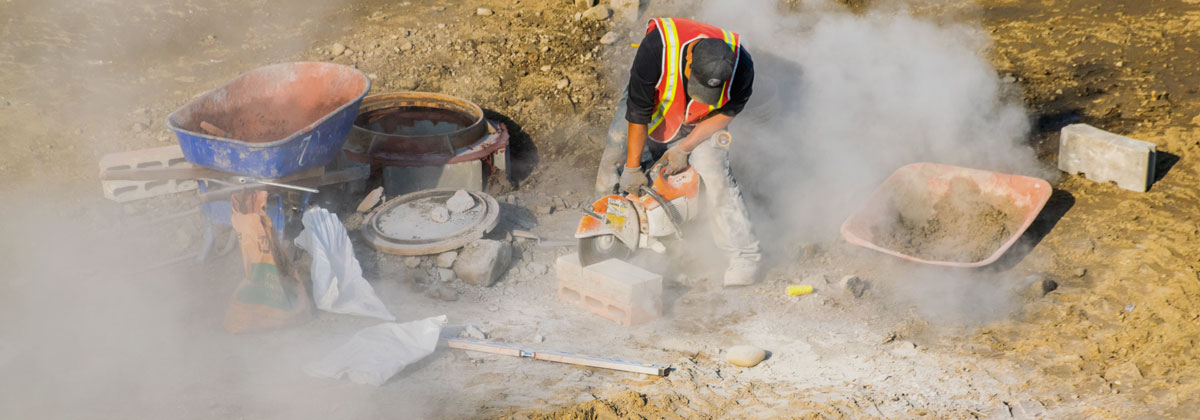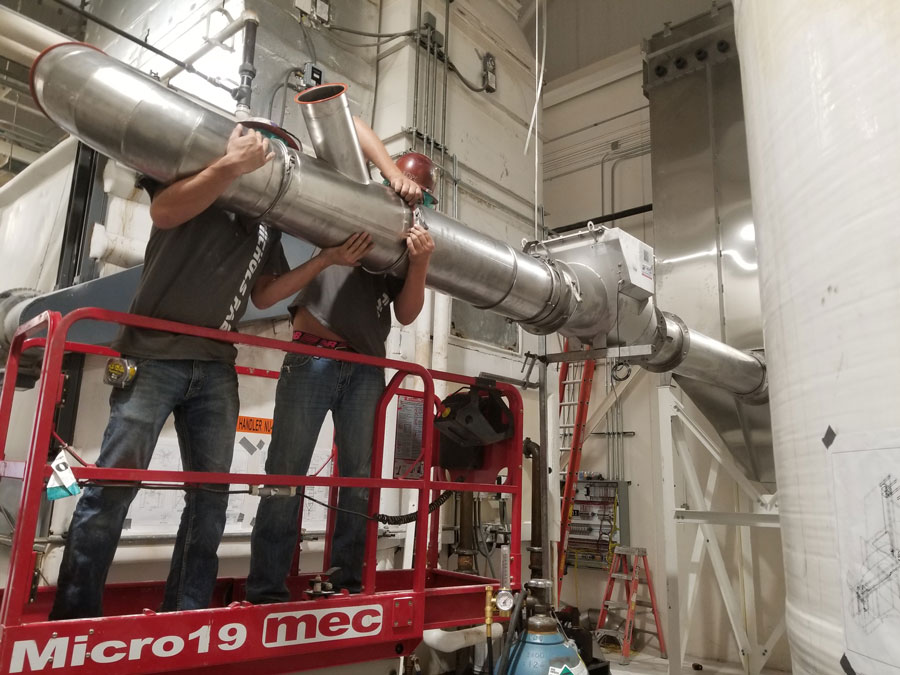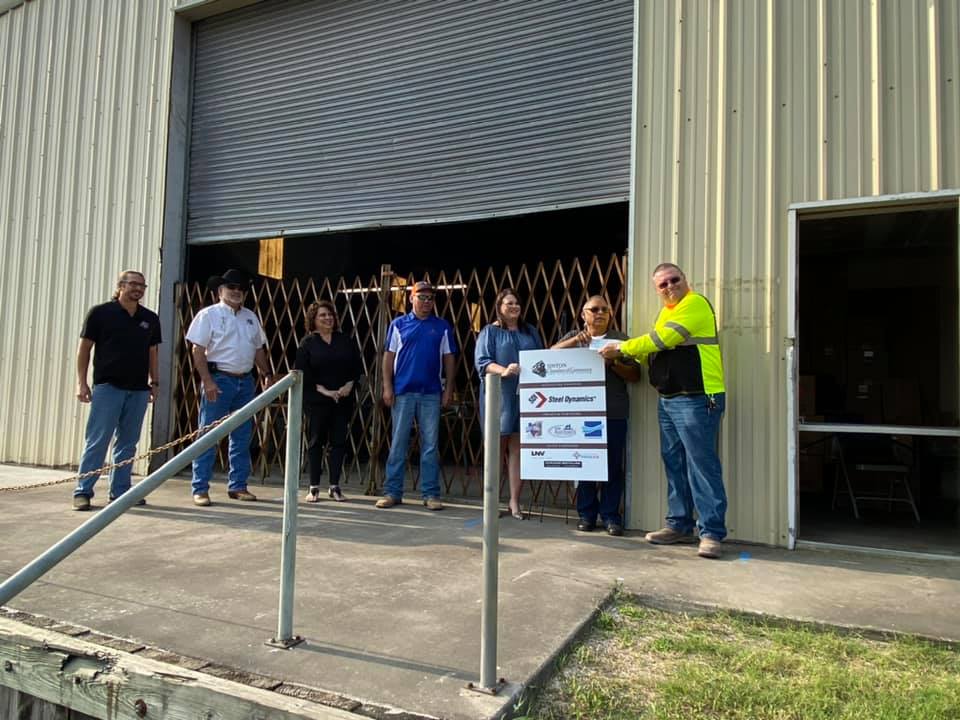Frac Sand Plants Now to Meet OSHA’s New Silica Exposure Rules

OSHA announced a final rule on March 24 to improve protections for workers exposed to respirable silica dust. According to the agency, the silica rule will curb lung cancer, silicosis, chronic obstructive pulmonary disease, and kidney disease in workers by limiting their exposure to respirable crystalline silica.
Silica dust is not ordinary dust and exposure to silica in the oil and gas industry can occur during a variety of dust generating activities. The hazardous component of silica dust is the respirable fraction: this means the very small particles that can penetrate deep into the lung. Different types and sources of silica may have different size ranges. Silica dust generated from sand can come from existing fines in the dust, or it can come from breaking the sand grains apart during handling. For example, dust generated from hydraulic fracturing may consist of a large portion of respirable particles. In contrast, silica dust generated while cutting concrete generally has a wider range of particle sizes.
Airborne levels above the PEL of respirable silica may not be visible, because the particles do not significantly block, scatter, and reflect light. The net result is that with many silica hazards, by the time it is visible, the airborne silica levels are well above what would be considered acceptable risk.
OSHA issued two standards to protect workers from exposure to respirable crystalline silica (RCS) — one for construction, and the other for general industry and maritime — in order to allow employers to tailor solutions to the specific conditions in their workplaces.
OSHA’s Final Rule
- Reduce the permissible exposure limit (PEL) for crystalline silica to 50 micrograms per cubic meter of air, averaged over an eight-hour shift. The new standards revise the 1971 standards.
- Require employers to use engineering controls (such as water or ventilation) and work practices to limit worker exposure; provide respiratory protection when controls are not able to limit exposures to the permissible level; limit access to high exposure areas; train workers; and provide medical exams to highly exposed workers.
- Provide greater certainty and ease of compliance to construction employers — including many small employers — by including a table of specified controls they can follow to be in compliance, without having to monitor exposures.
- Stagger compliance dates to ensure employers have sufficient time to meet the requirements, e.g., extra time for all general industry employers to offer medical surveillance to employees exposed between the PEL of 50 micrograms per cubic meter and the action level of 25 micrograms per cubic meter; and for the hydraulic fracturing (fracking) industry to install new engineering controls.
Compliance Schedule
Both standards contained in the final rule take effect on June 23, 2016, after which industries have one to five years to comply with most requirements, based on the following schedule:
- Construction: June 23, 2017, one year after the effective date. Construction industry employers are exempt from meeting the PEL and performing exposure monitoring to crystalline silica if they comply with the specific engineering controls, work practices and respirator use discussed in the new standards as outlined in Table 1 of the new rules.
- General Industry and Maritime: June 23, 2018, two years after the effective date to comply with most requirements; additional time is provided to offer medical exams to some workers.
- Hydraulic Fracturing: June 23, 2018, two years after the effective date for all provisions except Engineering Controls, which have a compliance date of June 23, 2021, for hydraulic fracturing employers to install dust controls to meet the new exposure limit.
Standards for General industry (including Frac Sand Plants) and Hydraulic Fracturing
The standard requires general industry and hydraulic fracturing employers to:
- Measure the amount of silica that workers are exposed to if it may be at or above an action level of25 μg/m (micrograms of silica per cubic meter of air), averaged over an 8-hour day.
- Protect workers from respirable crystalline silica exposures above the permissible exposure limit of 50 μg/m, averaged over an 8-hour day.
- Limit workers’ access to areas where they could be exposed above the PEL.
- Use dust controls to protect workers from silica exposures above the PEL.
- Provide respirators to workers when dust controls cannot limit exposures to the PEL.
- Restrict housekeeping practices that expose workers to silica where feasible alternatives are available.
- Establish and implement a written exposure control plan (ECP) that identifies tasks that involve exposure and methods used to protect workers.
- Offer medical exams — including chest X-rays and lung function tests — every three years for workers exposed at or above the action level for 30 or more days per year.
- Train workers on work operations that result in silica exposure and ways to limit exposure.
- Keep records of workers’ silica exposure and medical exams.
Conduct a Hazard Assessment
If your company has personnel at risk for silica exposure, you need to:
- Conduct hazard assessments for their specific operations as a component of their health and safety program.
- Implement appropriate controls to mitigate hazards to acceptable levels.
A series of questions provided below can assist you in conducting a hazard assessment.
Step 1: Is Silica Present at Your Worksite? Involve workers in this process and conduct a worksite tour.
Step 2: If yes, determine who might be at risk.
Step 3: Look at each group of workers and determine specific tasks that they conduct.
Step 4: Prioritize the exposures based on the workers/tasks that are anticipated to be the most elevated and by the number of workers at risk.
Step 5: Implement interim controls where elevated exposures are anticipated such as workers breathing visible dust that is known to contain silica and then conduct representative exposure measurements to determine airborne silica levels.
Step 6: Evaluate monitoring results and existing controls and determine if and what additional controls are required.
Step 7: Document and communicate results and control requirements to workers and management.
Step 8: Conduct inspections and periodic re-assessment or when change occurs. Examples of change may include a new site configuration, wind direction, introduction of new products, new controls, etc.
Develop a Silica Exposure Control Plan
The purpose of an exposure control plan (ECP) is to set out your company’s approach to protecting workers from harmful exposure to airborne silica dust.
A combination of control measures may be required to achieve this objective. You should commit to being diligent in your efforts to select the most effective control technologies available, and to ensure that the best practices, as described in this ECP, are followed.
The work procedures you establish should protect not only your employees but other possible effected personal. These guidelines should be designed to be used for continuous processes as well as per project when the need for a control plan may exist.
Hierarchy of Control Measures
Effective control options must be used to eliminate or reduce the risk to employees from the hazards of silica dust exposure. The following hierarchy of control measures can be followed:
Control Dust Exposures by Improving Existing Engineering Controls and Safe Work Practices
Engineering controls and work practices provide the best protection for workers and must be implemented first, before respiratory protection is used. Working with industry partners, NIOSH has identified the following control options for hydraulic fracturing operations:
1. Elimination and Substitution
Recognize the importance of planning the work in order to minimize the amount of silica dust generated.
Advocate for the use of methods that reduce the need for transferring sand. Whenever possible, schedule work when workers are present to times when less dust is released.
2. Engineering Control of Dust
Selecting an appropriate control measure depends on the specifics of the operation. In some cases, local exhaust ventilation (LEV) is the preferred method of controlling exposure (e.g., for drying, screening and transfer operations) than wetting methods.
In a different application, wetting may be more effective (e.g., controlling dust on roadways) than LEV, however, using LEV may reduce the amount of final cleaning required, as the silica dust is captured.
Control Dust Exposures by Improving Existing Engineering Controls and Safe Work Practices
Engineering controls and work practices provide the best protection for workers and must be implemented first, before respiratory protection is used. Working with industry partners, NIOSH has identified the following control options for hydraulic fracturing operations:
Short-Term Work Practice and Procedural Changes That Can Be Implemented Quickly:
Mandate the capping of unused fill ports (e.g., cam lock caps) on sand movers. Securing unused fill ports can help reduce the dust released, especially during filling.
Reduce the drop height between the sand transfer belt and T-belts and blender hoppers. Limiting the distance that sand falls through the air can help reduce dust.
Limit the number of workers, and the time workers must spend in areas where dust and silica levels may be elevated, and consider ways to perform dusty operations remotely to completely remove employees from these areas.
Apply fresh water to roads and around the well site to reduce the dust.
Practices That Involve Equipment Changes:
Enclose points where dust is released. Install thick plastic stilling or staging curtains around the bottom sides of the sand movers to limit dusts released from belt operation. Enclosures can also be added along and at the ends of the sand transfer belt.
Where possible, use enclosed cabs or booths. Consider configuring operator cabs and booths with HEPA filtration and climate controls to further protect workers.
Use local exhaust ventilation to collect silica containing dusts and prevent dust escape. Install dust collection systems onto machines or equipment that can release dust.
3. Administrative Controls
Employer management steps that can reduce silica exposure and support employee health:
- Prepare the site risk assessment with the help of qualified experts.
- Establish procedures for housekeeping, restricting work areas, personal hygiene, worker training, and supervision.
- As part of project planning, assess when silica dust may be generated and plan ahead to eliminate or control the dust at the source. Recognize that awareness and planning are key factors in the prevention of silicosis.
- Warning signs should be posted to warn workers about the hazards of silica and to specify any protective equipment required (for example, respirators).
- Work schedules should be posted at the boundaries of work areas contaminated with silica dust.
- Work that generates silica dust could perhaps be conducted after hours, when access by other unprotected workers may not be restricted.
- Develop a site-specific exposure control plan to cover project-specific issues (e.g., scope of work, project location and site-specific hazards) and to be kept available at the worksite.
4. Personal Protective Equipment
Respiratory protection
- All employees who wear respirators should do so in adherence with your respirator program.
- Respirators must be selected based upon measured exposure levels and the assigned protection factor of respirators.
- Only approved respirators should be used.
- Workers who wear respirators should be clean-shaven. Filtering face piece respirators give little or no protection to workers with beards, and even a minor growth of stubble can severely reduce the effectiveness of respiratory protection.
- All employees who wear respirators should be fit-tested.
- Employees should be properly trained in the use of respirators, and a high standard of supervision, inspection, and maintenance will be followed.
Protective Clothing
Your company should provide employees in a restricted area with protective clothing that protects other clothing worn by the employee from silica contamination, ensure that employees’ street clothing is not contaminated by silica, and ensure that an employee does not leave a restricted area until the employee has been decontaminated.
Health Monitoring
Exposures to airborne concentrations of Silica must be kept below the new permissible exposure limits. Full shift personal samples shall be representative of the employee’s regular, daily exposure to silica.
Documentation
Records must be kept of the following:
- All employees who are exposed to respirable silica dust while on the job
- Employee education and training sessions
- Respirator fit-testing
- Equipment maintenance and repair
- Worksite inspections
The exposure control plan must be reviewed at least annually and updated as necessary by the employer, in consultation with the workplace health and safety committee or the worker health and safety representative.
Risk Exposure Factors
A variety of factors impact the degree of exposure risk on site. Some factors that commonly apply to the majority of silica exposures are detailed below. An understanding of these factors can assist in selecting controls.
Time – How long is the duration of the exposure? Cumulative exposure is a better predictor of silica disease. As such, PELs are full-shift time-weighted averages (TWA) like the 8-hour PEL. Some task-based exposures may last only minutes, while others may last the entire work shift.
Proximity – How close are you to the emission source? The closer you are to the emission source, the higher the airborne silica concentration is likely to be.
Relative Dustiness – How dusty is the material or process? The dustier the material is, the more airborne dust may be generated. It is important to recognize that the manner in which the material is disturbed can impact the dustiness. For example, a product that is not dusty, such as clean sand, can generate dust when it is broken during handling.
Energy – Is energy being imparted into the silica-containing material? The more energy, the greater the airborne concentration of silica. Energy can come from the speed of conveyor belts or the action of screeners, the drop distance, the associated speed or air pressure used to pneumatically convey bulk sand, etc.
Quantity in use – How much is being handled? Generally, the more product in use, the greater the airborne hazard created.
Percentage Silica – What is the bulk silica percentage? Higher silica concentrations generally result in higher airborne silica levels, especially for pure sand rather than ceramics or coated sands.
Ventilation – Can silica build up in the air? The amount of ventilation can make a significant difference to exposures. Exposures in well-ventilated environments, like wide-open windy outdoor locations, may be less significant than exposures in poorly ventilated indoor environments. Wind can dilute the hazard, but can also take the hazard from one area and make it a hazard for others. This is of particular concern when the concentration is very high, as in hydraulic fracturing operations.
How Industrial Accessories Company Can Help
IAC has developed world class teams of process and environmental engineering staff and construction skilled personnel to help you identify and reduce your RCS dust emissions in order to allow your site to be in compliance with OSHA’s Final Rule Policy.
IAC has the expert experience and skill-sets necessary to provide you practical cost effective solutions to allow your company to mitigate dust emission at either Frac Sand Dry Plants or during your Completions at the well site. Our experience includes:
IAC’s in-house staff of civil, structural, mechanical and electrical engineers who will work with your company’s engineers or Environmental, Health and Safety staff to determine the best path forward.
- IAC can be your Engineering, Procurement and Construction (EPC) design/build general contractor.
- IAC has a wholly owned construction company, Adelphi Construction Company, LC, who is MSHA and OSHA trained to provide construction, installation, and modifications at your site.
- IAC is a baghouse dust collector original equipment manufacturer (OEM) providing over 30 years of product sales and service to North American as well as international markets.
- IAC is an OEM of pneumatic conveying systems as well as mechanical material transport systems.
- IAC provides Bulk Storage Systems consisting of either welded or bolted silos and is a field erector of both.
- IAC designs and programs Automated Controls including: PLC, HMI, and Local Control systems to match your plants existing controls.
- IAC provides a Dust Collection Performance Analyzer Control System to provide plant management with necessary data to demonstrate RCS dust reduction compliance; data collection and alarms; and operator interfaces to quickly trouble shoot, diagnose and solve baghouse dust collection performance issues.
Call IAC today for help in performing your risk analysis, in writing your exposure control plan or in preparing a budget for engineering controls to meet your scheduled compliance requirements.


